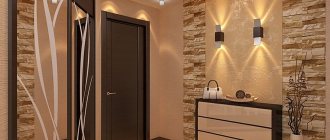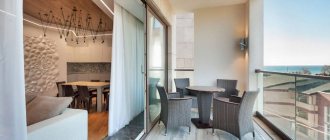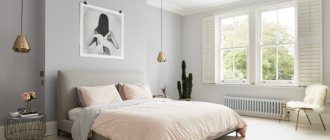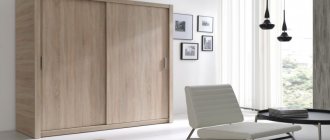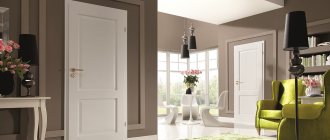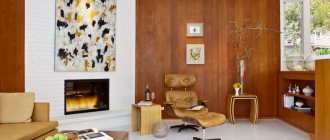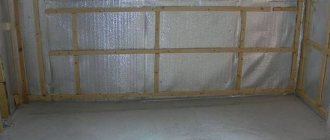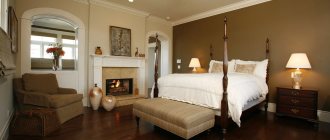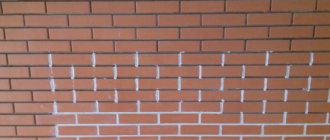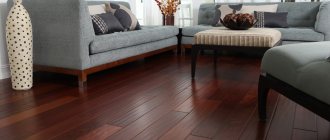There are currently battles going on among interior designers over flooring preferences. Some believe that the most obvious trend of the last decade is light-colored floors, sending dark floor coverings into oblivion. Their opponents focus on the shortcomings of light-colored floors and call dark floors a living classic, which is not afraid of any fluctuations of fickle fashion.
Dark floor
It should be noted right away that a dark floor is considered not only brown or black, but also dark shades of other colors.
The dark color of the flooring brings a feeling of warmth and comfort to the interior, but at the same time visually it noticeably conceals the space. Therefore, it is more logical to use dark floors in large rooms, adding glass and metal objects to them. When choosing, you need to remember that balance must be maintained: dark floor – light walls, otherwise the room will instantly turn into a gloomy dungeon.
Features of use
- Dark surfaces (except black) get dirty less and are more practical. But they also need regular care.
- The combination of “dark floor – light furniture” is considered common, but a number of designers recommend choosing objects that are only a few tones lighter than it for a dark floor.
- If such an interior seems gloomy to someone, creating a painful atmosphere, then these people can use the well-known design maneuver: combining a dark floor and light walls in the interior. Furniture in this case can be of any color, because such an interior is characterized by “omnivorousness”.
Advantages
- Many dark shades have a positive effect on a person’s well-being, they are calming and do not cause irritation. It has been noted that a light kitchen with a dark floor even helps to digest food better.
- The dark floor adds seriousness and solidity to the interior.
- It averages out the proportions of oversized accessories.
Flaws
- It is better not to make a dark floor in a room where there is not enough natural light, but, on the other hand, if the sun's rays directly hit the floor, they will highlight the slightest defects in the coating, and even a small amount of dust on its surface will immediately become noticeable.
- On a dark glossy finish, all the stains from washing the floor will be clearly visible. Therefore, after washing such a floor will have to be additionally polished.
- Dark varnish is very easy to scratch, and all the smallest scratches will immediately become visible.
Photo of a dark floor in the interior:
Choosing a dark floor shade
The final effect greatly depends on the correct selection of color tone, which can be understood by comparing a dark floor and light doors.
- Shades of chocolate will make the interior expensive and cozy due to their warmth.
- Thanks to the black color, the home will acquire a modern individuality and even extravagance.
- Somewhat aloof dark gray tones will make the atmosphere cooler.
Flooring color
When choosing a dark floor, you will need to decide on the shade. There are many tones of flooring today. Of course, a lot depends on the taste of the apartment owner, but various nuances should also be taken into account in order to achieve harmony in the interior:
- Black. You can choose this flooring if you want to make the interior of your bedroom or living room more solid. Black will “dilute” an interior decorated in white; it will make it more interesting. This floor is suitable for colored walls, beige, brown, golden wallpaper. Light doors and white or black baseboards go well with black flooring.
- Grey. This is a fairly neutral shade for the floor. You can choose a ceiling of the same color. Such floor coverings are suitable for loft, country, and marine styles.
- Brown. This color creates comfort in the room. Most often it is chosen for living rooms and bedrooms, but it can be suitable for any room. This is an ideal option for a rustic style chalet.
- Blue. This color is calming. Such floors are found quite often. Blue flooring is suitable for a room with a black or white door.
- Green. The grass-like floor is an accent and attracts the eye. For this reason, it is better to furnish a room with green flooring with fairly neutral furniture that will not draw attention to itself.
READ MORE: Do-it-yourself electric heated floor under laminate
Light floor
Compared to dark coatings, light ones are considered more versatile and can fit perfectly into a wide variety of interior styles. Such a floor can easily be combined with elements that have a calm color scheme, for example, if a baseboard that is lighter or darker than the floor is used. But bright objects fade significantly against their background. If dark furniture is purchased for a room, then it should be elegant, with smooth, thin lines.
Peculiarities
- When arguing about which floor is more practical, light or dark, the argument that light floors are too dirty is often used, which is far from the truth. To keep your home clean, you need to regularly clean surfaces of any color. Here, the quality of the protective layer is of greater importance, which protects the floor covering from deep penetration of dust and dirt, and then even a photo of a combination of a light floor and dark doors will delight anyone.
- Visually, a light floor will add volume to the room and make it much lighter.
- For some people, white and other too bright colors often cause discomfort. A solution to this problem can be a combination of a light floor with fairly dark walls.
- Light-colored floors in kitchens are quite common. Any interior items will stand out well against its background. The contrast of a light floor and dark kitchen walls can be softened by bright lighting of the work area and an abundance of shiny metal surfaces.
- When decorating a light-colored floor, special attention should be paid to the baseboards. For example, the combination “light floor – dark baseboard” can give the interior the necessary contrast and will be appropriate for any style. Most often, the floor surface is not monochromatic, but is diluted with low-contrast patterns, since an ideal white floor will look boring and cause discomfort.
Advantages
- Most often, dark doors and light floors in the interior can be seen in photos of living rooms, where there is also dark furniture. Thanks to this, the appearance of additional space is created, the room seems to be expanding. Keeping this property in mind, designers often recommend practicing similar solutions in miniature rooms.
- A light floor not only improves interior design, but also has a functional advantage, increasing the illumination of the room.
- It has long been known that if a room faces north and cannot boast of large dimensions, then light walls, light furniture, and a dark floor become almost the only practical solution for it.
Flaws
- It is important not to forget that for beige or white floors it is necessary to select pieces of furniture very carefully, otherwise they will lose their advantages and become the most trivial, unremarkable coverings.
- You can talk as much as you like about the fashionability and stylishness of light-colored floors, but it’s still difficult to call them respectable. You can even make the covering out of a beautiful gray laminate, but it won’t look as expensive as wenge or other dark wood, which can cost significantly less.
- The appearance of unwanted shades. Even if you look for a material with a certain shade, then after flooring, being in a specific environment, under a certain lighting angle, this same material can noticeably change its tone. Dark pieces of furniture will make it darker, and light ones, in combination with direct sunlight, on the contrary, will unnecessarily lighten it. As a result, the shade chosen for so long and meticulously will turn into something unimaginable, even almost yellow.
Photos of light floors in the interior:
The combination of a gray floor in the interior
Gray color is dearly loved by designers for its ability to be combined with most shades. It will add softness and texture to pastel palettes, dilute dark ones and soften complex colors, making them more natural.
A soft ash shade is irreplaceable in rooms with contrasting color schemes.
It removes aggression, makes a smooth transition in the contrasts of black and white, white and red, black and red.
Interiors that combine different variations of gray are stylish and elegant. In this case, it is better to make the floor in the lightest shade available or in the darkest. Bright details can add bright accents to a monochrome room. The latter can be yellow, orange, crimson, turquoise.
It is better if there are textiles, accessories, and finishing elements in a bright design. An excellent option is to paint one of the walls (or part of it) in the specified colors.
The gray floor forms a harmonious tandem with lavender, pale pink shades, as well as wine, pastel blue and green colors.
If we are talking about a room in a classic style, then it is recommended to use dark gold as a decoration.
It is recommended to combine a gray floor with doorways of the same shade. Another win-win option is a combination of a light gray floor with doorways and wenge or oak colored panels.
Thanks to the ash tone of the floor, wenge looks even softer and more elegant, and the oak shade looks even deeper and more majestic. By the way, wenge looks good with both warm and cold gray.
If the floor is a very light gray-beige, then milky, light brown and pastel doorways and doors will also work.
Gray color is capricious in combination with cold shades. The only exceptions are the blue and light blue palette.
Rules for interior combinations of dark and light floors
- A light ceiling + light walls + dark floor of the bathroom will make it visually larger.
- A dark ceiling + light walls + dark floor will reduce the height of the room, but make it wider.
- Light ceiling + dark walls + light floor draw attention to the horizontal lines in the interior.
- A light ceiling + a light wall (opposite from the entrance) + a light floor makes the room narrower, but the ceiling seems higher.
- Light ceiling + light walls + light floor in combination with a dark back wall visually makes the room less deep.
- A light ceiling + dark walls + dark floor can create a mysterious and slightly gloomy atmosphere of a dungeon.
- Dark ceiling + dark side walls + light back wall + light floor visually evoke the effect of being in an endless tunnel.
- If the entire room has the same dark color, then it is pointless to talk about its shape, it is simply lost.
How to visually change volume using flooring?
The selection of floor colors based on other surfaces significantly affects the overall appearance of the room. Having considered the combination of colors in the interior, you can create a table on how and what color to choose for the floor, ceiling, walls and furniture in order to significantly change the area.
| Floor shade | Wall shade | Ceiling shade | Furniture shade | Change of space |
| dark | light | light | light | Increases volume |
| dark | light | dark | neutral | increases the area, reduces the height of the room |
| light | dark | light | Dark or neutral | raises the height of the room, narrows the space |
| Dark | Dark | light | light | feeling of a basement or well |
| dark | One dark wall | light | light | the walls move apart relative to the dark wall |
| light | One dark wall | light | dark | reduces the length of the room, increases space |
| light | dark | dark | neutral | compresses the area, creating a feeling of a cave |
By choosing rich tones of all surfaces, you can get a closed cube, which is absolutely not comfortable to stay in for a long time. Such options are usually used when decorating large halls using birch furniture and good lighting, as well as when decorating nightclubs and bars.
The selection of floor colors based on other surfaces significantly affects the overall appearance of the room.
Having considered the combination of colors in the interior, you can create a table on how and what color to choose the floor
A light floor raises the height of the room and narrows the space
Depending on the desired result, the color texture of the floor is selected:
- tones of red - perfectly emphasize the contrast and prevail over other surfaces, clearly indicating the horizon;
- blue colors - expand the layout, preferable for the sunny side;
- shades of yellow – solar warmth and light;
- tones of green - create comfort and peace, well suited for creating a relaxation area.
Based on the above, we can conclude that in order to bring any plane closer, it must be made darker. To increase volume - light.
The floor can be made in one color scheme
To bring any plane closer, it must be made darker
See alsoDoors in the interior: choice of color, shape and type of construction
Correct combinations of flooring with other interior elements
If the room has light walls and floors, then it creates a feeling of lightness and spaciousness, but an excess of light colors can cause a feeling of cold officialdom, so it is more rational to adjust this situation to the “light floor - dark doors” interior.
Black or dark brown furniture harmonizes perfectly with light wood floors. Since light colors can actually make a dark room appear lighter, this technique is very often used for rooms with insufficient natural light. However, another effect needs to be taken into account here - the lighter the room, the cooler it seems, so you need to find the right balance, for example, using a combination of dark floors and light doors.
For dark floors, you can choose successful combinations not only with light, but also with dark walls. But still, you shouldn’t make the walls completely snow-white, but it’s better to choose a cream shade or ivory color. Dark colors should not prevail, otherwise the room will become too gloomy. But bright accents that will invigorate the atmosphere will be appropriate.
It is best for the furniture to be a couple of shades lighter or darker than the floor surface. If the colors of the floor and furniture exactly match, then it is advisable to separate them with a contrasting color carpet - this is how a light living room with a dark floor is often decorated.
If the floor is given a bright color, then it is better to give the walls warm or neutral shades, but you cannot use more than two different tones at the same time.
From what has been said, it becomes clear that there are a lot of options for decorating interiors with floors of dark and light colors - there is room to show your imagination.
Wallpaper color selection
- Choosing wallpaper is a responsible matter. Therefore, you need to take into account the type of wallpaper and its color. The color scheme of the wallpaper, ceiling and floor largely determines how a person will feel in the room. The color of the wallpaper, ceiling and floor will determine your mood, emotional state and performance. Therefore, you need to try to ensure that the color of the wallpaper and ceiling creates the most comfortable environment.
- Selecting the color of wallpaper for the ceiling is a very important stage in renovation. Quite often they try to match the color of the ceiling to the wallpaper, choosing a similar color scheme. If the color of the wallpaper in white shades is provocative, then the ceilings against the background of the wallpaper will become not very expressive and faded.
- Wallpaper of different colors can be combined in different ways. Light wallpaper is perfect for a small room. Such wallpaper will visually increase the space. Wallpaper in dark and sharp colors, on the contrary, will make the room smaller. You should also consider the natural light in the room.
- Wallpapers with frequent and large colors visually make the room smaller, while small and sparse wallpapers significantly expand the room. In addition, wallpapers with large floral patterns dominate within different styles. Wallpaper with small patterns is used mainly as a neutral style background.
- Green wallpaper indoors conveys the beauty of a natural theme. These wallpapers are perfect for almost any design, as they are combined with wooden elements and many colors.
Monochrome gray wallpaper complements bright furniture
Patterned and striped wallpaper in the interior
Wallpaper with a pattern under old paint
Blue wallpaper with white floor and furniture
The relationship between floor color and interior style
Dark floors do not suit all interior styles:
- For example, shabby chic generally requires the lightest possible floor made of bleached wood.
- On the other hand, an overly light or overly dark floor covering will not go well with classical styles (antique, baroque or rococo). In these interiors, a dark floor made of valuable wood would be much more appropriate.
- However, classical styles are too complex and expensive, and also less functional, so for today’s residential interiors, in the vast majority of cases, modern styles that are close in spirit to the surrounding life are chosen.
The combination of white floors in the interior
All shades, from light to dark, go well with white. The selection of companion colors will influence the subsequent perception of the interior.
The classic combination is white with black and red. The contrast of shades allows you to highlight details and correctly place accents. An example would be the design of the floor in white, the walls in black, and the presence of red accents. Or, alternatively, a combination of black and white tiles.
White plus sunny orange and yellow lift your spirits and charge you with energy when choosing bright shades. Pale yellow and washed out orange and white look much calmer and more elegant.
The emphasis on purple is often made by creative individuals who have many interests and are constantly developing. The perception of design in blue and green, with the presence of a white floor, also depends on the selected shades.
It can be contrasting and catchy with bright blue and sleepy green, or create the impression of a romantic and soft atmosphere when choosing soft blue and light light green tones.
A multifaceted classic combination can be white, which is mixed with a brown range of colors. At the same time, the result is warm, creamy chocolate combinations that do not irritate the eyes and can serve as the basis even for a classic interior.
Floor color and lighting
When making the final choice in favor of a light or dark floor, one should not lose sight of the nature of the general lighting of the room:
If the boards are located perpendicular to the incident light, they will appear brighter, and if they are located in the opposite direction, they will appear darker.
In general, the floor should be laid along the direction of the incident light, in which case the fastening of the panels will become less noticeable. In addition, it is necessary to take into account that the color of the floor covering under artificial lighting can change noticeably, so during the day and in the evening the appearance of the interior can change greatly.
In addition, the floor will be laid for decades to come, so when choosing a material for it, you need to be very careful, paying attention to its quality.
Are the floors in your home dark or light, and why? Explain your choice in the comments - your opinion and experience are important to us.
Selection of carpet and wallpaper
At one time, carpets went out of fashion and were rarely used in design projects. Today they are again an integral part of bedrooms, children's rooms and living rooms. The variety of patterns and pile heights allows you to use carpets and rugs in any room.
In order to achieve a good result, you need to decide not only on the shape, but also on the shade of the carpet.
- A dim room in pale colors will be decorated with a bright product. In addition to it, you can use decorative pillows made in the same color scheme.
- The classic style can be supported by a carpet with a calm pattern. The main thing is to choose a suitable shade so that it does not get lost and at the same time is combined with other elements of the decor.
- For small rooms, as a rule, large-sized carpet is chosen in calm and soft colors, preferably monochromatic. They will optically increase the size of any room.
- In large halls and bedrooms, small rugs with a three-dimensional pattern are laid to highlight any area. A voluminous flower or animal face looks great in a large space and presents itself favorably. Rich and warm colors are used in spacious living rooms to highlight a specific area.
The design of the room is made in one color scheme
The room design is made in light colors
A certain role in decorating an apartment is assigned to the purchase of wallpaper.
A certain role in decorating an apartment is assigned to the purchase of wallpaper. The colors and patterns applied to the walls are of great importance in visual perception:
- horizontal stripes on the wallpaper reduce the height, make the room wide and low; if you make only one wall in a long corridor striped, it will be visually closer;
- vertical stripes lift low ceilings, the effect increases with the width of the strip;
- a large pattern brings the walls closer, so in small apartments it is not recommended to use wallpaper with such a pattern or to cover only one wall with it in an elongated room;
- a small pattern expands the walls - cream wallpaper with a small pattern applied to it optically enlarges the space;
- wallpaper with wide transverse stripes pasted onto the ceiling brings the opposite wall closer and pushes the side ones apart; this method is widely used when creating the interior of narrow halls and corridors.
Cool colors can visually increase the area of a room
Light shades are preferable to use in large rooms
Based on the above, the following conclusions can be drawn.
- Bright, rich warm and dark cool tones reduce the space, but at the same time make it original. They are unacceptable for small apartments.
- Pale pastel and light cool shades increase volume, expand walls and raise ceilings. They can be used in the design of any room.
See alsoImitation wood on the wall in the interior - an unusual design element
If the floor is made white, light light beige or light gray
If we talk about flooring, there are laminate, vinyl tiles, parquet, which are called bleached oak, beech, Norwegian pine and other similar names. In fact, they are not pure white - there are shades of gray, beige, and brownish. But the general impression is that it is an almost white floor. It creates a feeling of cleanliness and spaciousness. If there is a slight gloss, it also visually increases the space.
With a neutral light floor, you can choose any decor
You can also find plain white, but this is not so interesting, although, if played correctly, it will also be very good. Paint the plank floor with a very light paint, and you will get exactly what the floor coverings imitate. How to choose the color of the floor if you don’t know what the decor will be? Choose something from very light shades. You can't go wrong, as it goes with almost everything, it can be in any style.
Paint the walls white
If you make a white floor and white walls, you will get a calm interior. The good thing about it is that by changing textiles and accessories, you change the style. You can easily change your mood. For some, such an interior may be boring, but it can be enlivened with bright fragments. White floors and walls are a great backdrop for any color.
In a combination of white floors and white walls, the furniture can be light or darker. There are any accents - black, red, blue, green, yellow, lilac, purple, etc. Any other colors you want in your home. But don't forget the three-color rule: you shouldn't add more than 3 colors. They can be in shades, but there should be no more than three “groups” of colors.
Combined with light colored walls
Add a little color to a white floor by painting the walls or using colored or plain wallpaper in light shades. Now it’s fashionable to make accent walls, so this technique fits well with this option: white floor and light walls, and the accent wall is either the same color, but saturated, or contrasting.
If you don’t know how to choose the color of the floor in a small apartment, try this option. You can create very diverse interiors and use different styles.
If you add dark paint
Dark walls with a white floor - this technique must be used carefully. It's too easy to create an uncomfortable interior. Dark walls are grey, black, brown in rich shades.
Such interiors turn out to be interesting, but living in them is “hard”. The option is acceptable only in very bright rooms with high ceilings. This technique should not be used in standard apartments. So the light floor-dark walls option is suitable for houses with high ceilings. And then, in order for the interior not to be too heavy, the doors and furniture should be light.
Colored bright wallpaper or paint
If you combine bright colors on the walls with a white floor, you get a bright and cheerful room. Colorful walls are blue, green, red, pink and any other you want. The degree of “brightness” is again at will and/or according to the purpose of the room. Ideal for children's rooms, good for living rooms if you like this option. May occur in the kitchen and bathroom.
To avoid it being too colorful, don’t mix too many colors and keep the furniture and textiles in subdued tones. Accessories can be bright, but in small quantities. Add more neutral or “blurred” pastel shades of the same color. It is important not to overdo it with flowers.
Cold and warm combinations
To create an interior in which being in will not cause aggression and irritation, fatigue and melancholy, you should study the rules for combining warm and cold shades. Warm tones include yellow, red, green, red, beige, and peach. These colors look like juicy fruits, remind you of warm summer days, and charge you with positivity. The green tint gives a feeling of stability, security, and peace. These colors are often used in the design of a kitchen or living room. You should use red with caution, as there is a risk of giving the room a vulgar look.
Patterned tiles in the bathroom
Brown striped floor in the living room
Light brown parquet
White floor and brown doors
Light carpet with a geometric pattern in a black and brown interior
Popular cool shades include gray, ash, silver, blue, light blue, and violet. Cool blue and blue tones give a marine accent, give freshness and vigor. The silver color scheme creates a winter fairy tale, while the purple color scheme is associated with spring.
Brown parquet and fireplace surround with beige wallpaper
Light brown floor and white doors
White carpet on a gray carpet
Light wooden parquet in the bedroom
Beige rug in the interior
The predominance of cold tones can reduce the feeling of comfort, so it is recommended to dilute such colors with warm shades. The main thing is not to overdo it to avoid disharmony. The dominance of warm tones needs to be cooled with splashes of cold, and vice versa.
Dark brown laminate flooring in the kitchen
Red and beige carpet on white floor
Dark floor in a light bathroom
Dark gray laminate
Patterned and striped wallpaper in the interior
